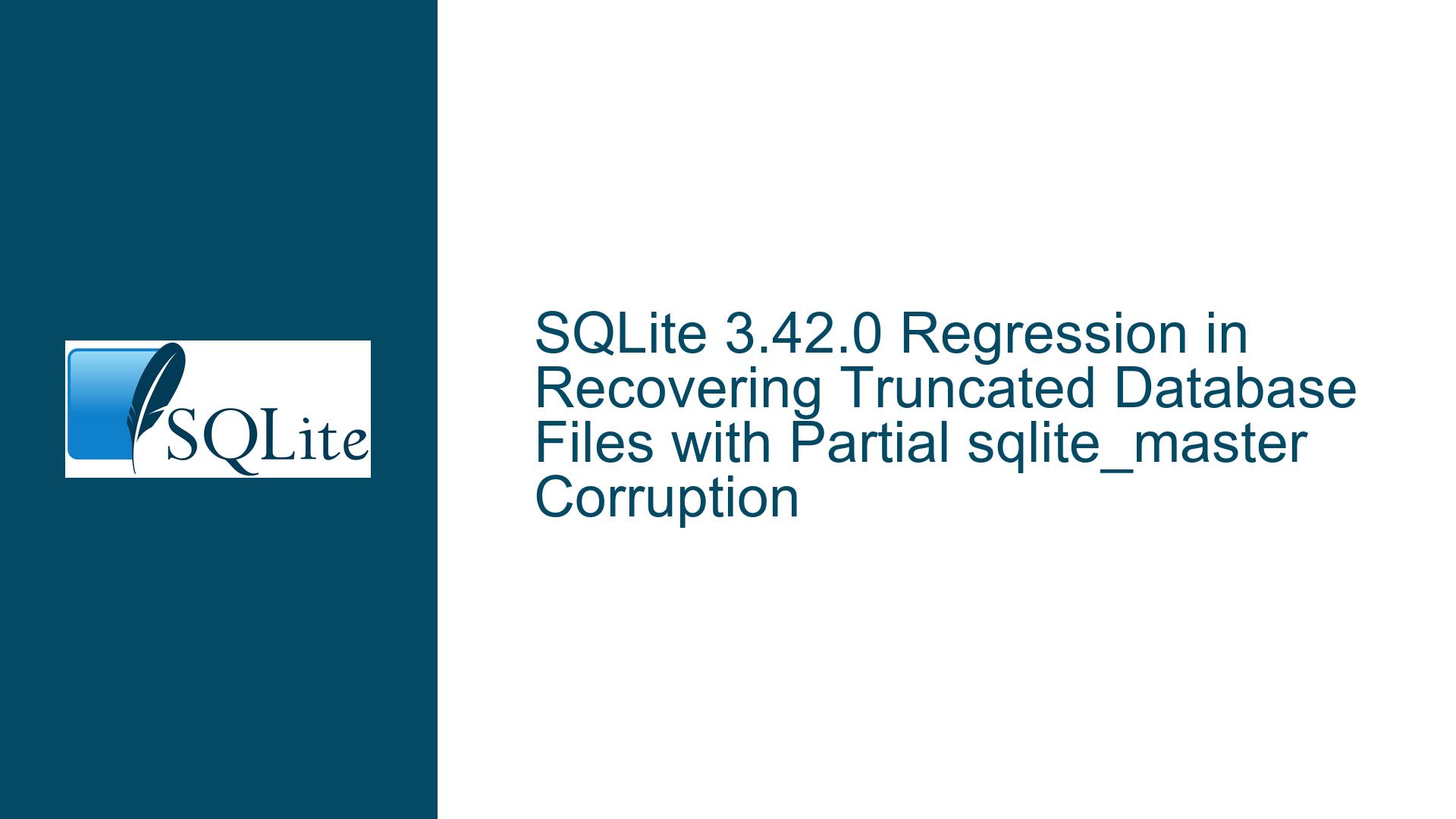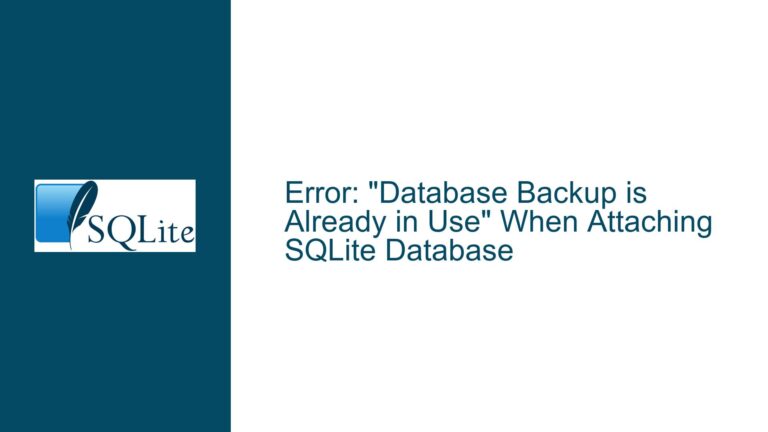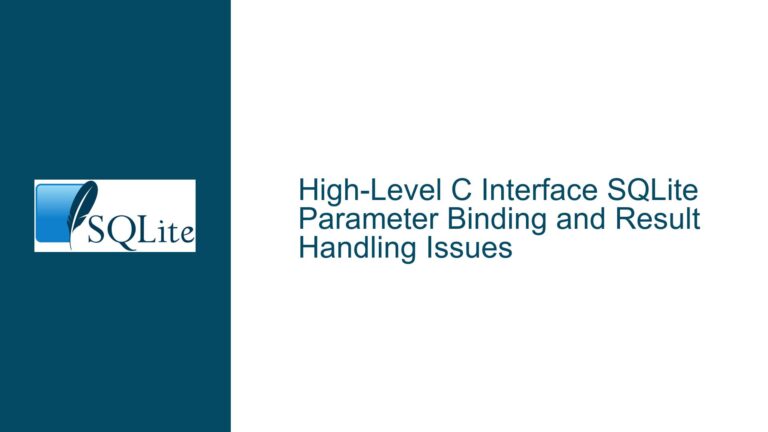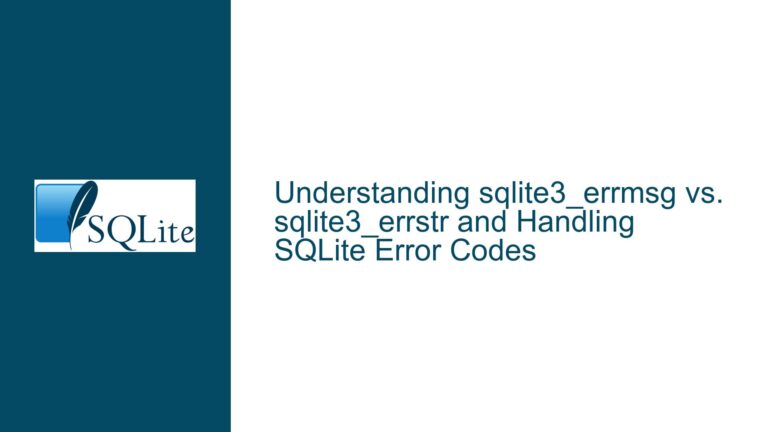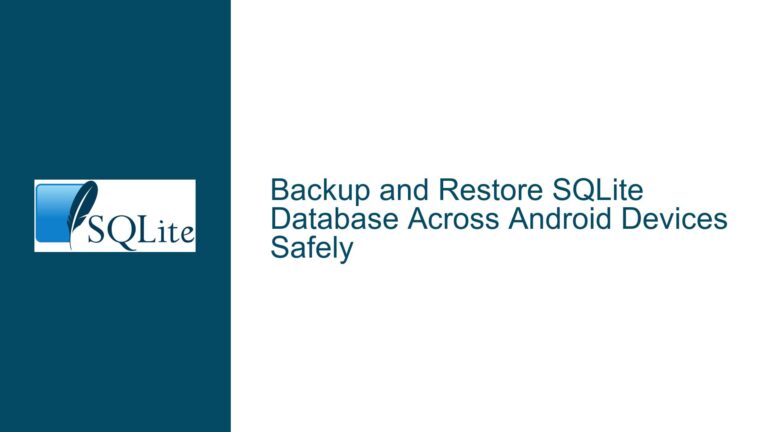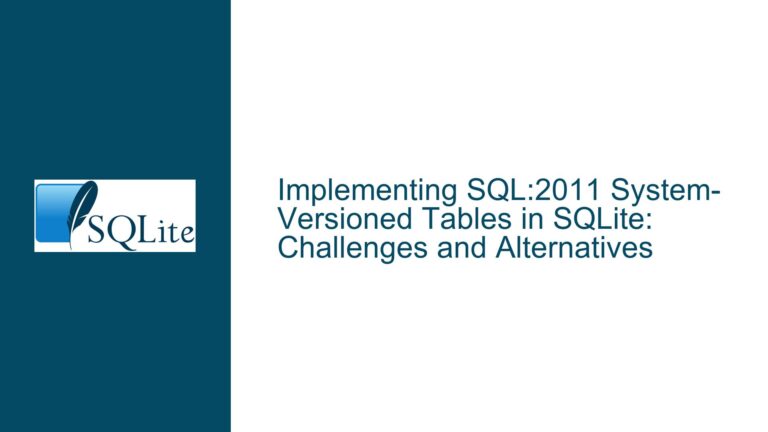SQLite 3.42.0 Regression in Recovering Truncated Database Files with Partial sqlite_master Corruption
Database Recovery Failure Due to Partial sqlite_master Page Corruption in SQLite 3.42.0
Issue Overview: Truncated Database File Recovery Behavior Change Between SQLite 3.41.2 and 3.42.0
A critical regression was identified in SQLite version 3.42.0 involving recovery of partially corrupted database files, specifically when truncation damages the sqlite_master table stored on page 14 of the sample database. The failure manifests when attempting to dump a 14,000-byte truncated version of a 15,360-byte source database (15 pages at 1,024-byte page size). While SQLite 3.41.2 successfully dumped this truncated file, version 3.42.0 fails unless the file retains at least 14,400 bytes (14 full pages plus 256 bytes).
The sqlite_master table contains essential schema metadata, spanning pages 1, 12, and 14 in this database. Truncation to 14,000 bytes occurs at offset 0x36B0 (14,000 in decimal), which bisects page 14 at byte 688 (0x2B0 in page offset). This truncation point damages critical schema information including index definitions for bans_jail_ip and bans_ip, while leaving portions of table definitions for bans intact. The regression suggests changes in SQLite’s handling of partial page content or schema validation logic between versions.
Key technical details include:
- Page 14 contains sqlite_master entries for bans table indices
- Truncation destroys the CREATE INDEX statement for bans_jail_ip at offset 0x3E0-0x3FF
- Remaining data includes partial CREATE TABLE statement for bans (0x2C0-0x350)
- SQLite 3.42.0’s stricter validation prevents partial schema reconstruction
- The .dump command relies on intact sqlite_master content to generate SQL schema
This regression impacts applications like fail2ban that use heuristic database recovery methods, where partial database files are processed through .dump output redirected to new databases. The version-specific behavior change indicates modifications in either page validation, freelist handling, or schema reconstruction logic during database initialization.
Root Causes: Schema Validation Improvements and Page Handling Changes in SQLite 3.42.0
Three primary factors contribute to this regression:
1. Enhanced Schema Validation During Database Initialization
SQLite 3.42.0 introduced stricter checks when parsing sqlite_master entries. The parser now validates complete statement syntax rather than accepting partially readable entries. In the truncated database, the broken CREATE INDEX statement at 0x3E0 ("CREATE INDEX bans_jail_ip O") lacks closing parenthesis and index definition. Version 3.41.2 may have ignored this incomplete entry while 3.42.0 rejects the entire schema as corrupt.
2. Modified Free List Handling and Page Allocation Checks
While the database doesn’t use free lists (all pages are allocated), SQLite 3.42.0 changed how it verifies page continuity. The truncation to 14,000 bytes leaves page 15 (the final page) incomplete. Previous versions may have ignored missing trailing pages if they weren’t referenced, but 3.42.0 appears to validate total page count against the file size more rigorously. This explains why 14,400-byte truncation (14 full pages) works – it maintains valid page count for file size.
3. Changes to the .dump Command’s Dependency on sqlite_master Integrity
The .dump command in 3.42.0 makes stricter assumptions about sqlite_master completeness. When entries are partially missing or corrupted, it aborts entirely rather than attempting to dump valid fragments. This contrasts with 3.41.2’s behavior of dumping recoverable portions while ignoring corrupted entries. The regression suggests improved safety checks that inadvertently broke legacy recovery workflows.
Additional contributing factors include:
Page Header Validation: SQLite 3.42.0 may validate b-tree page headers more thoroughly. Page 14’s header at offset 0x3400 shows a 0x0D page type (interior table b-tree) but contains leaf page content. Previous versions might have tolerated this mismatch if the page wasn’t accessed, while 3.42.0 flags it during schema parsing.
Pointer Map Awareness: If pointer maps (used in WAL mode) are enabled, SQLite validates parent/child page relationships. Though the database uses rollback journal, code path unification in 3.42.0 could introduce unintended validation steps.
Schema Parsing Algorithm Changes: The transition from recursive descent to table-driven schema parsing in recent versions may have reduced tolerance for partial entries. The broken CREATE INDEX statement acts as a parsing roadblock in 3.42.0.
Resolution Strategy: Mitigation, Workarounds, and Long-Term Fixes
Immediate Mitigation for fail2ban and Similar Applications
Use .recover Instead of .dump
SQLite’s dedicated .recover command (introduced in 3.22.0) uses more sophisticated reconstruction algorithms:sqlite3 corrupted.db ".recover" | sqlite3 recovered.dbThis command:
- Scans all pages for valid records, bypassing sqlite_master
- Reconstructs schema from found data
- Handles partial pages more gracefully
- Works with SQLite 3.42.0 on truncated databases
Adjust Truncation Test Thresholds
For existing .dump-based workflows, increase the "recoverable" truncation threshold to 14,400 bytes (14 full pages) when using SQLite ≥3.42.0. This ensures all sqlite_master pages (1,12,14) remain intact.Implement Robust Recovery Validation
Replace the "non-zero file size" check with schema validation:if sqlite3 recovered.db "PRAGMA quick_check" | grep -q "ok"; then echo "Recovery successful" else echo "Recovery failed" fi
SQLite-Level Workarounds
Legacy Compatibility Mode
Re-enable 3.41.2-style lenient parsing using runtime flags:sqlite3_db_config(db, SQLITE_DBCONFIG_LEGACY_SCHEMA_PARSING, 1, 0);Note: This is a compile-time option not exposed in the CLI.
Manual Schema Reconstruction
Extract valid SQL fragments from damaged databases:strings -n 60 database_v1.db | grep -i "CREATE"Combine output with .dump of recoverable tables.
Long-Term Solutions
SQLite Codebase Fixes
Propose patches to make schema parsing more resilient to partial entries:- Allow skipping unparseable sqlite_master entries with warning
- Add PRAGMA ignore_schema_errors=ON to bypass schema validation
- Improve .dump’s fallback behavior when sqlite_master is corrupted
Application-Level Improvements
- Transition from .dump to .recover in fail2ban’s recovery workflow
- Implement probabilistic recovery checks rather than binary size tests
- Add version-specific truncation thresholds in test suites
Enhanced Corruption Handling Documentation
SQLite documentation should clarify version-specific recovery behaviors and recommend .recover over .dump for file corruption scenarios.
Detailed Diagnostic Steps
Confirm Truncation Impact with sqlite3_analyzer
Build the SQLite shell with sqlite3_analyzer and inspect page usage:sqlite3_analyzer database_v1.dbCompare output between 3.41.2 and 3.42.0 to identify validation differences.
Trace Database Initialization
Use SQLite’s diagnostic features to log schema parsing:SQLITE_TRACE=sqlite3_trace database_v1.db "SELECT * FROM sqlite_master"Compare how each version processes damaged sqlite_master entries.
Hex-Page Analysis
Inspect damaged page 14 content:dd if=database_v1.db bs=1024 skip=13 count=1 | hexdump -CIdentify exact corruption points affecting schema parsing.
Conclusion
The regression stems from SQLite 3.42.0’s improved schema validation conflicting with legacy recovery methods that relied on partial sqlite_master tolerance. While the change enhances data integrity protection, it breaks workflows assuming lenient corruption handling. Migrating to .recover and implementing robust validation checks provides both immediate relief and long-term stability. Developers should balance corruption resistance with recovery flexibility through version-aware truncation thresholds and enhanced diagnostic instrumentation.
